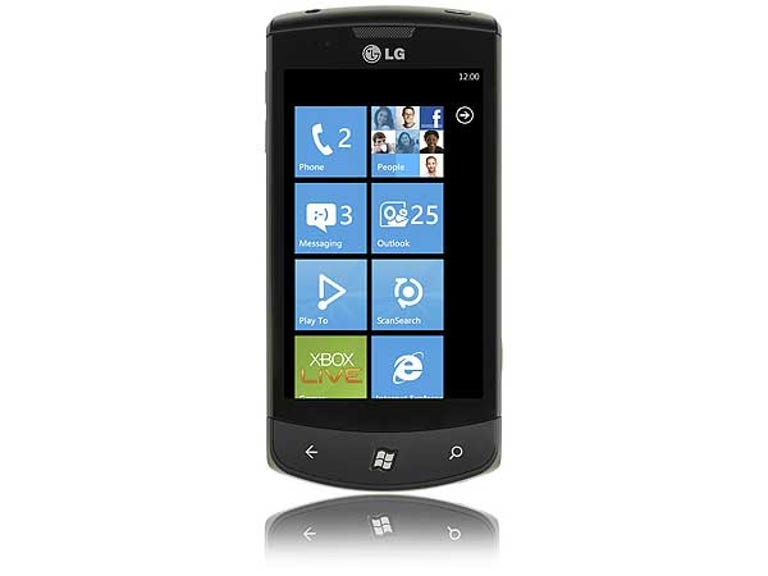 Why You Can Trust CNET
Why You Can Trust CNET LG Optimus 7 review: LG Optimus 7
The Optimus 7 looks like it could be one of LG's best smartphones to date, but is that enough to steal sales away from the WP7 offerings from HTC and Samsung?
On paper the Optimus 7 doesn't seem to stack up well against the Windows Phone 7 (WP7) competition. It reads like its Windows Phone sibling, the Optimus 7Q, minus the Q's slideout QWERTY keyboard, and it is, after all, made by LG, a company not renowned for making excellent top-shelf devices. But we urge you to read on, in the melee of five new WP7 phones reviewed simultaneously, the Optimus 7 has earned its place at the top of this list.
The Good
The Bad
The Bottom Line
Design
LG may not be known for producing class-leading smartphones, but it does regularly release some pretty sexy handsets. The Optimus 7 is no exception; its 3.8-inch LCD touchscreen is the centrepiece in this design, but it's the attention to detail we appreciate most. We like the way the ends taper outwards, the brushed metal finish on the battery cover and the trim around the 5-megapixel camera lens. But if there's one part of this phone we like above all others, it's the real, mechanical buttons below the screen.
The first round of Windows Phone handsets are uniformly plagued by a lack of mechanical buttons. HTC, Samsung and LG have all opted for touch panels for navigation rather than mechanical keys, a choice that trades off a level of usability for an assumed aesthetic appeal. The Optimus 7 differs in this regard, below its screen are three depressible navigation keys. This will seem like the height of nit-picking to some, but after you've accidentally quit out of applications more than a few times you'll understand why we regard this feature so highly.
The screen is a WVGA resolution TFT display, and though this pales in comparison to Samsung's Super AMOLED technology (literally), the screen on the Optimus 7 still does a fine job of displaying clear, colourful images.
There's a 3.5mm headphone socket on the top of the handset, alongside the screen-lock key, and you'll find a dedicated camera shutter button on the lower right side. The battery cover is removed with a nifty ejection switch on the back of the phone, and returns to its original position nicely, laying flush with the rest of the handset, following its curves seamlessly.
Features
As with all of the other WP7 phones we've reviewed over the past few weeks, the Optimus 7 matches Microsoft's required hardware spec, and is limited by it as well. It supports a full range of connectivity options, with HSPA network compatibility, Wi-Fi including wireless N, A-GPS, Bluetooth, plus it adds to the basic suite with DLNA media streaming (but not receiving).
Like the 7Q, the Optimus 7 also has twice the on-board memory of its competition, with 16GB of non-expandable storage. Its 5-megapixel is the basic spec for WP7, but the quality of the sensor is quite good, and the LED flash does a good job of illuminating dark scenes and acting as a fill flash. Its digital zoom feature is basically unusable, but then, digital zoom is always pretty rubbish.

The 5-megapixel camera does a decent job of capturing colour
(Credit: CBSi)
You also get access to a range of exclusive LG-created apps, which are by far the best we've seen from the manufacturers so far. Pre-installed on our review unit were a panoramic photo stitching tool and an augmented-reality nav app, similar to Layar. A quick glance at the Marketplace and we discovered a half dozen more, including music rhythm games and a Tool Kit with a range of mini apps within. We've also been told by LG that it plans to co-develop up to 10 new apps every quarter and that these are exclusive to LG WP7 handsets.
Performance
If you've been following our coverage of Windows Phone, you'll know that our experience with all of the WP7 range of handsets has been universally excellent, and the Optimus 7 is no exception. From the time you unlock the screen to the moment you lock it again, you'll experience smooth graphic transitions and good performance both in the menus and within all of the core apps. The only time you will come across any lag in the navigation is when the phone is pulling down data from the web, like Facebook status updates when you enter the People hub.
A standard business day of use wasn't enough to fatigue the 1500mAh battery in the Optimus 7, though for us a standard day includes up to an hour of talk time only. If you were to add another hour to this, or exceed our two hours of daily web browsing, you might need to keep a charger at work.
Overall
If you've read this far, you're probably wondering how the addition of three mechanical buttons and 16GB of memory equate to the Optimus 7 being the best Windows Phone 7 handset of the launch devices. After all, Samsung has its amazing Super AMOLED screen, and the Optimus 7Q has a QWERTY keyboard. The Optimus 7 feels like a more complete package, the screen appears brighter and more colourful than the 7Q and the absence of a keyboard doesn't phase us. Its design is as nice to look at as the phone is to hold and use, and the extras, like the memory and LG's apps, are icing on the cake.
Ultimately, when you're comparing phones with such similar specs and functionality, it's the little things that grab and hold your attention. We like using the Optimus 7, we didn't have the same problems with the camera that we did with the Omnia 7 and we feel it's a more attractive WP7 phone than those on offer from HTC at this time.


